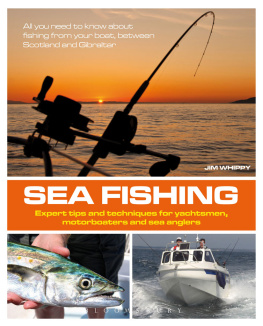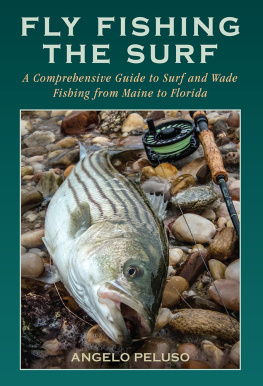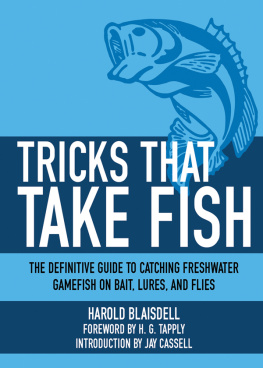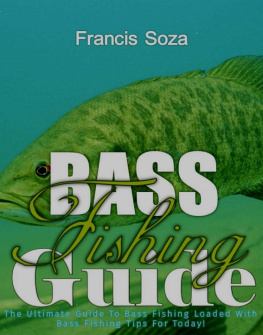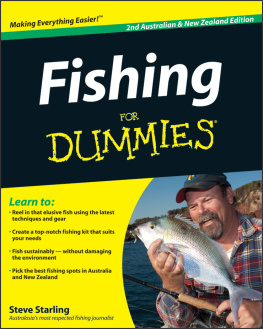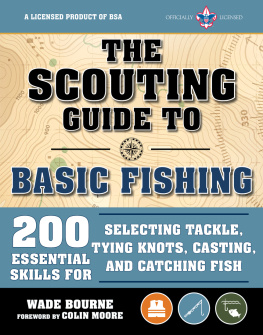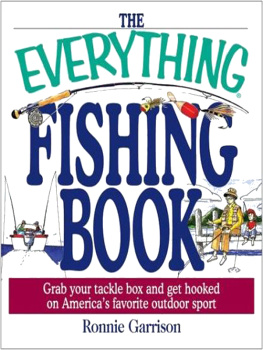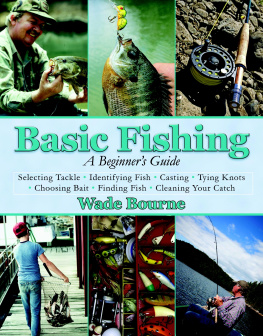
This book provides a few ideas on how to catch fish for people who are not skilled in sea angling. Its aimed at those who sail, cruise or just spend time on the water around the coast of the British Isles.
The weekend sailor will often see mackerel shoaling or a bass rising and wonder, How could I catch a few for dinner? Theres nothing better than a bit of fresh fish straight from the sea and in this book the author uses clear pictures and instructions to show you how to make a catch. The book is intended as a guide to show how to catch fish while cruising along, drifting or peacefully at anchor, because different methods are required for each. There are numerous pictures showing clearly which fish are likely to be caught so they can be identified easily. We have also included sections on what you can catch as you travel further afield and how to prepare the fish for cooking with some suitable recipes for use on board using limited ingredients and utensils.
Rods can be kept on board with feathers on, in case a shoal of mackerel is spotted on the surface. They can then be swiftly dropped over the side and hopefully catch a few fish while they are still in the area. For other species the tackle will require some slight changes that we will guide you through.
For the absolute beginner we explain the basic tackle required and move on to show how to get the best out of each item and when it should be used. We cover in a step-by-step format a few knots that are most commonly used by boat anglers and give a rundown on baits and how to present them to the fish. In each section of the book we identify the likely species that will be caught using that particular method and warn if any of them need careful handling due to sharp spines, fins or teeth.
The first method of fishing we look at is trolling because this is by far the easiest way to catch something as the fish generally hook themselves, and the boat can continue its journey while you are fishing. Trolling is generally carried out with the rod secured in a rod holder and left there until a fish takes the lure and starts the rachet going as it takes off line. Lures can be a set of six mackerel feathers or a single lure or spinner and, providing a suitable weight is used to keep it working just under the surface, the fish will do the rest.
We then show how to fish on the drift with the baits being pulled across or near the bottom. Drifting can be very rewarding as baits can be employed that will attract a wider range of fish than are found by exclusively trolling. If the ground is very rocky a paternoster rig, with hooks suspended off the bottom, will work best and keep tackle losses down to a minimum. Over sandy ground or gravel a flowing trace with a hook on the bottom is best for flatfish and several other species.
Then we explain how rewarding fishing at anchor can be, especially for the larger species of fish. At the end of a days sailing or cruising, with the anchor securely down, its fun to put a rod with a decent sized bait over the side to see what you can catch. In a strong tide, the tackle needs a suitably-sized lead weight to hold the bottom and allow the fish to find the bait.
Fishing from a boat doesnt require a lot of expensive equipment or high levels of skill to start with, but once you catch the bug you will be hooked for life and want to find out more about the subject. This book will hopefully encourage you to expand your knowledge and try different methods of angling, alternative baits and find out more about the different fish we identify in each section.
Anyone who regularly goes afloat whether in a motor cruiser, dinghy, yacht or kayak will have seen evidence of fish jumping or shoaling on the surface and maybe wondered how to catch them. Showing how to do this is exactly what we want to achieve with this book, without too much technical jargon and fancy expensive equipment.
A wide range of sea fish can be caught using basic and inexpensive tackle if you follow the simple instructions. Fish are not difficult to catch provided you use the right methods at the right time for each particular species. What this book will give you is the basic knowledge about the feeding habits of fish, their favourite habitat and how to catch them, calling on the shared experiences of professional anglers.
The most basic method a set of feathers.
To start with, the very minimum equipment is a rod, reel, set of feathers and a lead weight. With this very basic setup it is possible to catch at least ten different species: mackerel, scad, garfish, pollack, bass, gurnard, pout, coalfish, codling and whiting. They wont all be caught on the same day or in the same area, but during a seasons fishing this is the potential.
Tackle shops are full of different rods, but what are they all for? We look at which rods are required for someone starting out and when to use them. Its the same with reels, the choice is sometimes overwhelming, but in fact there are really only two basic types the fixed spool reel and the multiplier. One reasonably priced multiplier and a cheap fixed spool reel will suffice for all the methods shown in this book.
TERMINOLOGY
The names of the equipment, tackle and fishing methods can be confusing so here is a simple explanation of some that may crop up when discussing sea angling.
Trolling | Pulling a lure behind a moving boat. |
Gilling | Working an artificial eel on a long flowing trace. |
Downtiding | Fishing from an anchored boat with the line over the stern. |
Uptiding | Casting tackle with a grapnel lead uptide from an anchored boat. |
Main line | The line on the reel. |
Trace | The line that holds the hooks. |
Flowing trace | A flowing trace is one fished on the bottom of the seabed below the weight, while a trace is either referred to as up the line or a paternoster rig. |
Paternoster | A trace with hooks suspended above the weight. |
Clutch | The drag setting on the reel that allows the line to be pulled off. |
Tubi or running booms | A device that holds the weight and allows the line to run through. |
MULTIPLIER ROD
A multiplier rod is one set up to take a multiplier reel. This means it doesnt have a large bottom ring like the fixed spool rod because the line comes off a multiplier reel fairly straight. A fixed spool reel lets line off differently and needs a large bottom ring to allow the line to run through easily.
It really doesnt matter too much what rod you use as any old rod will catch fish. The most important item will always be the right bait or lure. What I can advise is which style of rod will be easiest to work with, and you need to get as close to this suggestion as possible depending on how much time you intend to spend fishing.

